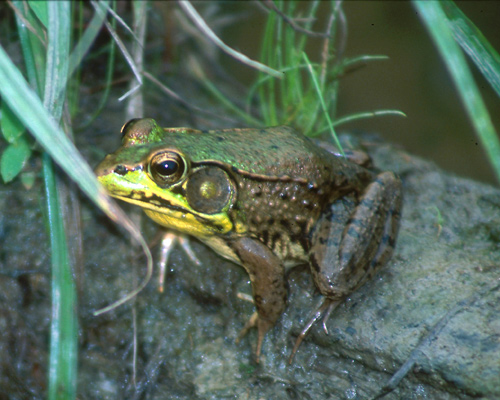The green frog is common in Connecticut. Its skin can be green, brownish or bronzy on top with mottling. Large round eardrums are visible behind its eyes. In the males these circular eardrums are larger than the eyes. Males have a yellow-colored throat while female green frogs do not. Green frogs can be 2 to 4 inches long.
Sometimes green frogs are mistaken for young bullfrogs that have not yet reached full size. They can be distinguished from the bullfrog by thin ridges along their upper sides. These ridges are called dorsolateral ridges and run from behind their eyes nearly to the crease of their hind leg.
Green frogs range through the eastern half of the US, and edge into southeastern Canada. They are very common throughout Connecticutand are the are the most abundant frog in New England. Green frogs live in permanent or temporary ponds, lakes and streams, and in marshes. These mostly aquatic frogs lounge in the water or perch on the banks. Tadpoles live in the water until they reach maturity. Green frogs are active during the warm season and hibernate for the winter underwater, buried in the mud on the bottom of a waterbody. They are most active at night.
Adult green frogs are insect-eaters. They hunt bugs by shooting out their sticky tongue to trap an insect and draw it back into their mouth. Green frogs can eat smaller amphibians as well. Most often they hunt from water. Immature green frogs, tadpoles, feed on plant matter.
Green frogs usually emerge from hibernation around March or April. Mating season begins in late April or early May but can continue through the summer. Male green frogs sing mating calls to attract a mate. A male grabs the female around her chest with his front legs and clings until she lays her eggs in the water. He deposits sperm on top of them. The thumbs of a male green frog swell during the mating season to make clasping easier. The female frogs produce about 3,000 to 5,000 eggs in several gelatinous masses attached to plants below the water surface. In a few days the eggs hatch into greenish tadpoles. It can take 3 months to 2 years for the tadpoles to absorb their tails, grow legs and develop lungs and they can overwinter in the tadpole form. Tadpoles live only in the water. Adult green frogs can be in or out of water.
Green frogs are solitary, except when they congregate in breeding waters in the summer. The mating calls of the males sound similar to the twang of a loose banjo string being plucked-"Glug! Glug!". Click the green frog call link below the photo for an example.
Frogs produce their calls by inflating part of their mouth lining under their throat with air through an opening in the bottom of their mouths. They then close off their mouths and nostrils and pump air between their lungs and this vocal sac over their vocal chords. The vocal sac of a calling frog is clearly visible as a bubble under his throat.
Neat Facts
When a green frog is at water's edge and someone or something approaches, it will leap into the safety of the water with a "plop" and let out a startled squawk. This alarmed squawk led to the green frog being called the "screaming frog".
